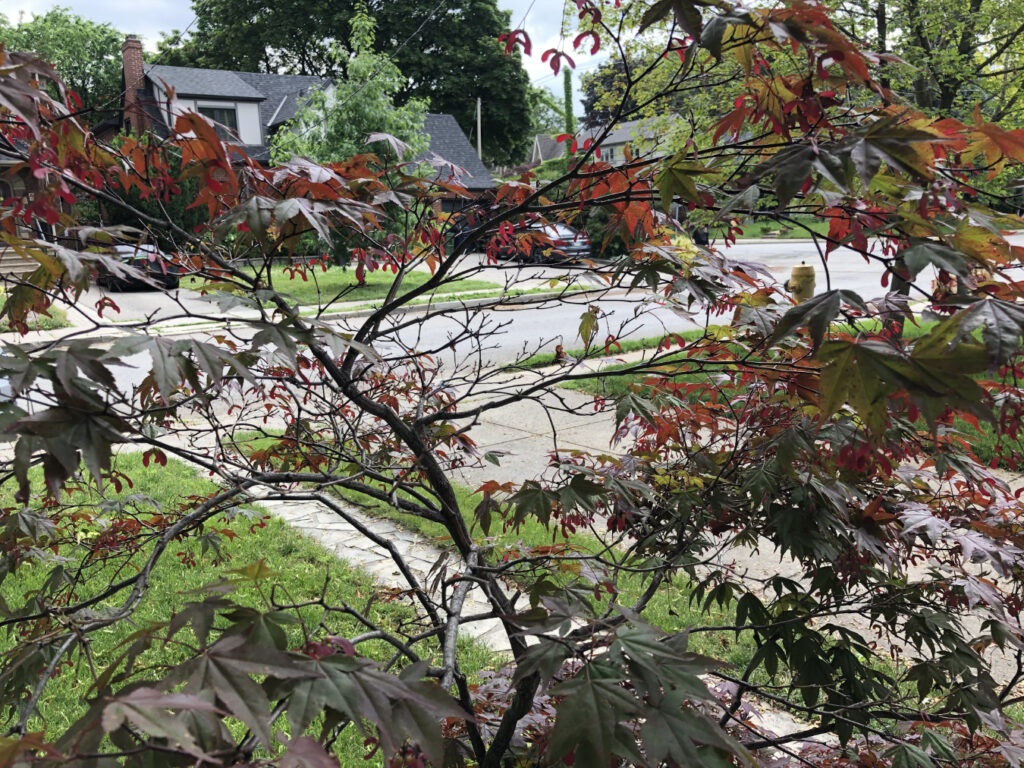(Question)

Hello and thanks as always for being there to give us the benefit of your wisdom.
I am in the Leaside area of Toronto – zone 6b.
My Bloodgood (I think it is Bloodgood – I planted before I started keeping notes on, and putting labels in, my garden – my memory is poor!) is about 20 years old, facing south-easterly and is planted under a very obnoxiously thirsty and selfish Norway Maple. It gets morning sun until about noontime. Despite the poor soil conditions, it has held up remarkably well all these years. After the torrential and long lasting downpours we have had the past few days (I am not complaining – am grateful to have rainwater!) I have noticed dozens and dozens of healthy leaves lying under the J. Maple. I cannot tell you if they were falling off before the rain, but I don’t believe so. As you can see from my photos, the leaves are healthy and seeds are being produced. But now some of the wee branches are a little bare looking as so many leaves are on the ground.
The tree was getting sprinkler water every day through May as we were trying to get overseeded grass in our lawn to grow and this has never been a problem for the tree in the past.
Do you think the rain could have knocked off all those leaves and, if so, will they grow back? Is there anything I should do to help that happen? Or is there possibly something else going on?
As always, I am grateful for any advice.
(Answer)
I am sorry to hear that your Japanese maple is struggling. As you probably know, your tree is deciduous- so if it is in relatively good health, it will regrow new leaves next spring. Japanese maples have secondary buds, so it is not uncommon for them to grow new leaves later in the same year.
Although it is possible that a freak storm could have blown the leaves off your tree, leaf drop in June is more likely to have occurred as a symptom of stress. Your tree is old and has done well so far, considering its neighbour is a Norway Maple. You didn’t mention any pests or unusual growths or wounds on the bark, so I think the most likely cause of the summer leaf drop is moisture stress.
According to J.D Vertrees (a world expert on all things concerned with Japanese Maples), a uniform supply of water is the key to maintaining a healthy tree. This doesn’t necessarily mean a lot of watering, but rather a consistent watering routine. If your tree grows in a relatively dry soil, then water during hot weather to prevent the soil completely drying out. If your garden soil is a naturally moist environment, then its important to not let it dry out when you’re away for extended periods.
Vertrees believes that sudden changes in moisture levels cause moisture stress, which leads to summer leaf drop.
In your case, I think it is possible that your tree may have experienced the typical dry out that occurs between rainfalls during Toronto’s warm late spring period. Seeding your lawn and watering your maple daily could have triggered the stress response, leading to the untimely leaf drop. The heavy rain may have just sped up the process.
Leaf scorch is another cause of leaf drop. Even a few successive days of dryness can make the maple leaves susceptible to scorch- if the sun gets warm enough and the ground is dry. If your lawn sprinkler sprayed the weakened leaves, it could have accelerated the scorch response. It sounds like your tree isn’t in full sun during the heat of the day, so I think leaf scorch is unlikely.
Over watering can also cause issues, but this tends to occur in poorly draining soils. The tree can become waterlogged and the roots struggle to breathe. Wet soil creates an ideal environment for pathogens to breed. This can lead to root rot and other fungal infections of the stems and leaves. Your tree looks quite healthy, and has grown for many years in this spot, so if poor drainage was an issue you would expect to see problems every year.
Japanese maples have relatively shallow root systems, so you can help your tree by mulching around is base every year or two to help keep a consistent soil moisture level. The mulch will break down over time and release nutrients into the soil- which may get to your ‘Bloodgood’ maple before the Norway maple! The mulch also offers some insulation to the roots on hot days and over winter.
In their native range, Japanese maples grow in soils that are slightly acidic and with a moderate amount of organic matter. Although Japanese maples don’t like large amounts of fertilizer, you can add an inch of organic compost, or vermicompost (aka worm castings), around your tree as far as the drip line. This will slowly release small amounts of nutrients into the soil for your maple to access. Avoid animal manures, seaweed or fish compost as they tend to be high in nitrogen. This can cause rapid growth of weak branches, more susceptible to temperature and diseases.
If you think your maple could do with a top dressing of compost, make sure you do it soon. If you wait until later in the summer, you may stimulate growth that will be too immature to withstand the frosts in late autumn.
Cover the compost with a layer of mulch about 2 inches deep, making sure the mulch is pulled back a few inches from the tree trunk, to prevent moisture being trapped against the bark-which can lead to fungal infections and rot.
Good luck with restoring your lovely tree back to good health!


